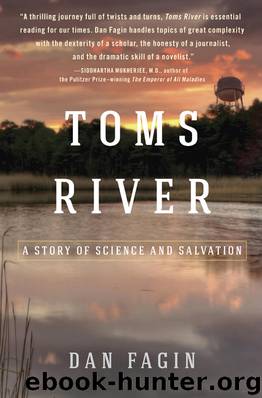Toms River by Dan Fagin

Author:Dan Fagin [Fagin, Dan]
Language: eng
Format: epub, mobi
ISBN: 978-0-345-53861-1
Publisher: Random House Publishing Group
Published: 2013-03-18T16:00:00+00:00
CHAPTER FIFTEEN
Cluster Busting
By the spring of 1995, when Steve Jones called to ask him to look into a possible cluster of childhood cancer in Toms River, Michael Berry had been New Jersey’s chief cluster investigator for almost nine years. It was still just a part-time responsibility—Berry spent most of his time on other tasks at the state health department—but it was now the least enjoyable part of his job. One of the first “incidence analyses” Berry ever attempted was the 1986 study of childhood cancer in Toms River. Its ambiguous results turned out to be a harbinger of dozens of similarly unsatisfying cluster studies he undertook around the state—including another one about Toms River kids in 1991. “After a while, it got frustrating,” he recalled many years later. “I mean, what were we accomplishing?”
A cluster study in New Jersey was like one of those old-fashioned Hollywood movie backdrops that looked fairly impressive until you leaned on it and it toppled over. Berry’s frustrations ran much deeper than just the usual problems with the state cancer registry, which in 1995 was still in poor condition, its records incomplete and arriving three years late or longer. As he accumulated years on the job, Berry came to realize that even if the registry had been up-to-date and reliable, he would not have been able to tell callers what they really wanted to know: whether an environmental problem was causing cancer in their neighborhood. For reasons that were not easy to explain in a phone call, it was a question Berry could not answer. In fact, Berry spent almost as much time explaining the limitations of cluster studies as he did conducting them. Sometimes Berry felt his job was more about being a therapist to anxious callers—he got about thirty cluster calls per year—than investigating what they told him. “It was hard to believe I was really addressing anybody’s concerns,” he recalled.
Most of the people who called him had at least three major misunderstandings about cancer patterns, each of which led them to assume that all clusters had a hidden cause and that Michael Berry could unearth it—if only he tried hard enough. The first misunderstanding was the nature of clustering itself. As Berry knew, everything clustered to a degree, often for no reason other than chance. Nothing that was subject to the complexities of the natural world, whether birds in a flock or sick people in a city, was distributed evenly in space and time. Some clumping was inevitable. In cancer incidence studies, the challenge was not to find the clumps—that was usually pretty easy, thanks to the registry—but to identify which were likely to have an underlying cause other than randomness.
The second misunderstanding was about the ubiquity of cancer. In adults, it was a much more common condition than most people recognized. In the mid-1990s, there was one new case per year for every 230 New Jerseyans. A more striking way to think about that was that an American man faced a
Download
This site does not store any files on its server. We only index and link to content provided by other sites. Please contact the content providers to delete copyright contents if any and email us, we'll remove relevant links or contents immediately.
Man-made Catastrophes and Risk Information Concealment by Dmitry Chernov & Didier Sornette(4958)
The Revenge of Geography: What the Map Tells Us About Coming Conflicts and the Battle Against Fate by Kaplan Robert D(3674)
Zero Waste Home by Bea Johnson(3381)
In a Sunburned Country by Bill Bryson(3061)
COSMOS by Carl Sagan(3045)
Good by S. Walden(3025)
The Fate of Rome: Climate, Disease, and the End of an Empire (The Princeton History of the Ancient World) by Kyle Harper(2558)
Camino Island by John Grisham(2483)
A Wilder Time by William E. Glassley(2438)
Organic Mushroom Farming and Mycoremediation by Tradd Cotter(2371)
Human Dynamics Research in Smart and Connected Communities by Shih-Lung Shaw & Daniel Sui(2239)
The Ogre by Doug Scott(2214)
Energy Myths and Realities by Vaclav Smil(2142)
The Traveler's Gift by Andy Andrews(2095)
9781803241661-PYTHON FOR ARCGIS PRO by Unknown(2048)
Inside the Middle East by Avi Melamed(2018)
Birds of New Guinea by Pratt Thane K.; Beehler Bruce M.; Anderton John C(1978)
Ultimate Navigation Manual by Lyle Brotherton(1830)
A History of Warfare by John Keegan(1817)
